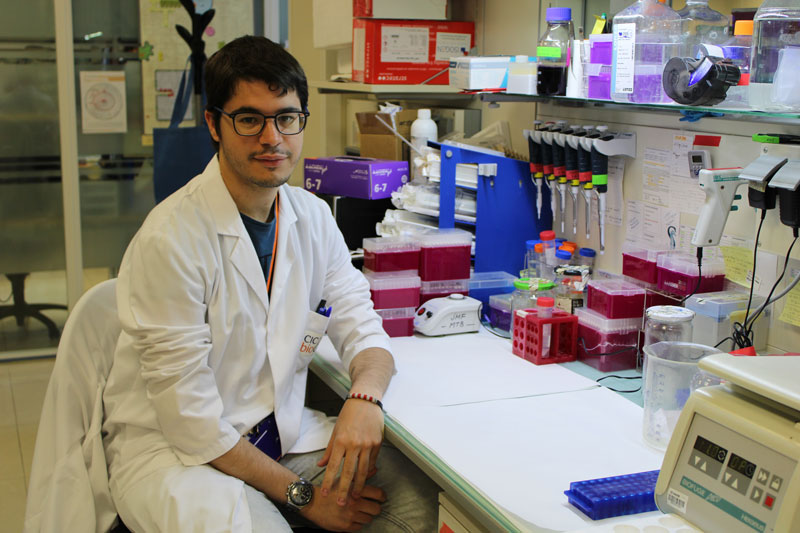
2019/09/04
Researchers at CIC bioGUNE identify biomarkers useful for fibromyalgia diagnosis
The research paper, published in the journal EBioMedicine, reveals a low proportion of certain bacteria in gut microbiome in fibromyalgia patients.
(Bilbao, 4 September 2019). Researchers at CIC bioGUNE, in collaboration with the University Hospital of Donostia, have identified a list of potential biomarkers for the diagnosis of fibromyalgia. The study, published in the journal EBioMedicine, reaffirms the idea that fibromyalgia is a real disease, with molecular differences that may help explain it and serve as a starting point for discovering possible therapies.
Fibromyalgia is a disease of unknown etiology characterised by chronic widespread pain that the patient experiences in the locomotor system. In addition to pain, other symptoms, such as intense fatigue, sleep disorders, numbness in extremities, depression, anxiety, joint stiffness, headaches and the sensation of swelling in the hands, are among the most common clinical manifestations. Patients with fibromyalgia often present a hypersensitivity to pain manifest in the appearance of a painful sensation to pressure in multiple sites of the locomotor system, which is not observed in healthy subjects.
The study, led by Juan Manuel Falcón, Ikerbasque researcher at CIC bioGUNE, combines different state-of-the-art '-omics' technologies that provide highly detailed information on the composition of the samples. "These technologies have enabled us to identify molecular differences that may be associated with fibromyalgia, a disease for which there is no objective diagnostic method," Juan Manuel Falcón explains.
Chronic pain at the systemic level, not localized, has caused the disease to be associated with the central nervous system. "Our hypothesis in the study was that this association with the central nervous system could be reflected in the gut microbiome - the population of gut bacteria - given the proven existence of the gut-brain axis, through which various mechanisms have been proposed by which gut bacteria can communicate and interact with the host," he adds.
Through this combination of '-omics' technologies, with particular emphasis on the microbiome and metabolome, the study proposes a series of bacteria that appear to be associated with certain symptoms of the disease. "In particular, we have found a reduction of the bacteria responsible for degrading a specific metabolite, glutamate, present in many metabolic pathways and associated with inflammatory processes and pain. Certain bacteria can degrade this glutamate to another molecule called GABA, which acts as a pain inhibitor, and it is precisely these bacteria that we have found reduced in fibromyalgia patients", adds Marc Clos-Garcia, first author of the work.
Fibromyalgia is still a very unknown disease, even among doctors, despite the fact that it is common in Spain, with a prevalence of 2.4% of the population over 20 years. It is often considered to be an unreal disease: patients tend to be seen as exaggerated and may even be ignored, which has given rise to many legal problems in the workplace. This means that, until a reliable diagnosis is made, patients go from doctor to doctor, each one recommending a different drug regimen. Considering that the microbiome is highly dependent on external factors, including diet, the fact that the patient community included in the study was very diverse in terms of treatments followed made it difficult to establish associations between the microbial community and the disease, as well as to identify the effect of the drugs on the microbiome.
Currently, a questionnaire consisting of up to 40 items on the presence or absence of different types of symptoms is used to diagnose fibromyalgia. This implies that, beyond an overall pain index, a multitude of factors may influence the diagnostic process. Again, each of these factors may alter not only the microbiome but any other molecule we could have measured. Controlling these factors was, again, complicated, since the diversity within the patient cohort itself was considerable.
Importance of the patients in the research
Bizi Bide, the Guipuzcoa Association for Fibromyalgia and Chronic Fatigue Syndrome, has been instrumental not only in managing the recruitment of patients but also the necessary health controls, for which the collaboration of patients’ relatives was also requested. In addition, annual meetings have been held with them to report on the progress of the study, in which their participation and collaboration has been full and extensive.
The multidisciplinary study, conducted with the support of the Basque Government, has been coordinated by the Exosome Laboratory of CIC bioGUNE. Likewise, the Metabolomics, Genome Analysis and Bioinformatics Service platforms of the same research centre, together with the medical teams of the Pain Unit of the Galdakao-Usansolo Hospital and of the Neurology and Rheumatology departments of the University Hospital of Donostia, coordinated by Dr. Adolfo Lopez de Munain, have all taken active part in the study. Furthermore, the research has been taken forward in close collaboration with BIOEF and with different laboratories of CIC bioGUNE, the University of Deusto and the Biodonostia Health Research Institute.
About CIC bioGUNE
The Centre for Cooperative Research in Biosciences (CIC bioGUNE), located in the Bizkaia Technology Park, is a biomedical research organisation conducting cutting-edge research at the interface between structural, molecular and cell biology, with a particular focus on generating knowledge on the molecular bases of disease, for use in the development of new diagnostic methods and advanced therapies. CIC bioGUNE has been accredited as a “Severo Ochoa Centre of Excellence”, the highest level of recognition for centres of excellence in Spain. CIC bioGUNE is a member of the Basque Research and Technology Alliance (BRTA), a public consortium formed in collaboration between the Basque Government, the SPRI Group, the Provincial Governments and the Cooperative Research Centres and Technology Centres of the Basque Science, Technology and Innovation Network. The aim of the BRTA is to ensure a "dynamic of cooperation" which enables us to meet the future technological and industrial challenges of the Basque Country and improve its international standing and impact.
See a large version of the first picture





